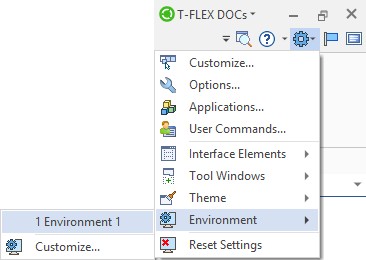Saving User Settings. Environments



Saving User Settings. Environments |
  
|
Settings made in the commands SO: Set System Options and SB: Show Toolbars, as well as in some other commands, can be saved using the Environments mechanism. Created Environments are used to quickly set up the system.
Environment is a set of system settings that can be saved in the Windows Registry: the visibility and composition of toolbars, special system windows, library and folder windows, the system settings, default customizations of various commands. An Environment may also include the settings made in various system windows (variables editor, databases, etc.) and, as was already mentioned, all settings defined in the commands SB: Show Toolbars and SO: Set System Options.
Environments are created by the user. Created Environments can be edited and deleted.
By using Environments you can quickly set up the system in a desired way by simply applying an earlier saved Environment. You can create an unlimited number of Environments. In this way, for example, you can arrange convenient working of several users on one work seat: save each user's Environment with one's personal settings and apply it when needed. Besides that, Environments can be stored in external files and, therefore, be loaded from external files. This allows porting T-FLEX CAD settings from one work seat to another one.
The main work with Environments (creating, editing, deleting, applying, export/import from an external file) is done in the SB: Show Toolbars command dialog on the “Environment” tab. This was described earlier in this chapter, the section “Customize Toolbars and Keyboards”, the topic “'Environment' Tab”. Here we will describe the method to quickly apply already created Environments.
The Environments existing in the system can be quickly loaded using the textual menu Customize > Environment. All Environments existing in the system are added there automatically.

To use any of the Environments, you just need to go into the said menu and select the desired Environment from the list.
Customize > Environment > Customize… command serves to quickly open the SB: Show Toolbars command dialog on the “Environment” tab.